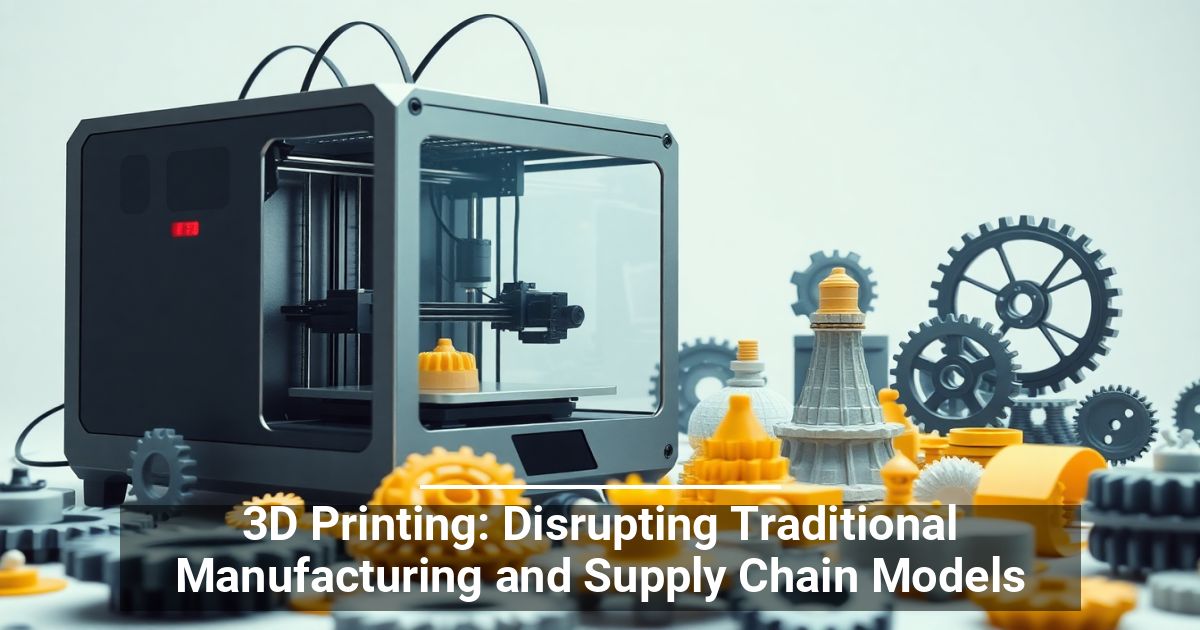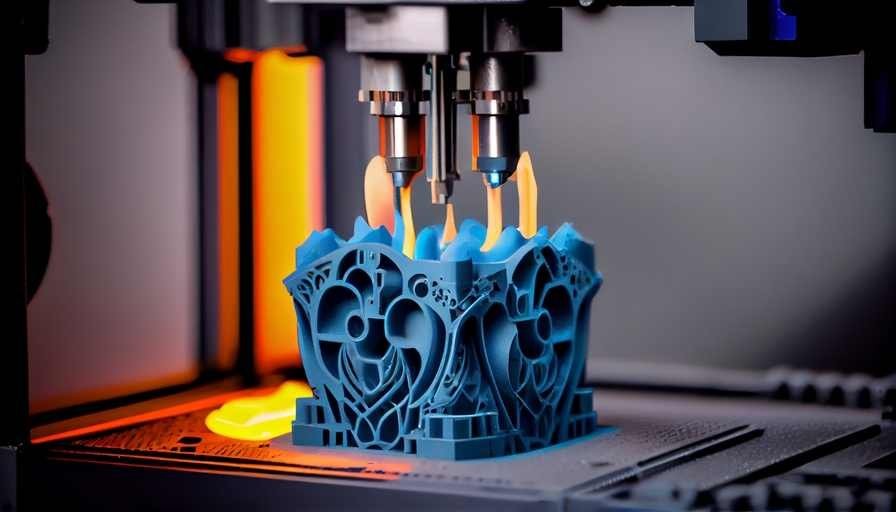Introduction: The Revolution in Manufacturing
Traditional manufacturing has long relied on processes like injection molding, casting, and machining to create products. These methods are efficient, but they also come with limitations, such as high material waste, long production times, and high costs for creating molds and tools. However, 3D printing, also known as additive manufacturing, is transforming the way products are made, offering a new way to design and create items with more precision, less waste, and greater flexibility.
In this article, we will explore how 3D printing is disrupting traditional manufacturing, its benefits, and the challenges it poses to industries that have depended on traditional methods for years.

What is 3D Printing?
3D printing is a technology that creates three-dimensional objects by layering material, typically plastic, metal, or resin, based on a digital design. Unlike traditional manufacturing, which often involves subtracting material from a larger piece (like cutting or milling), 3D printing adds material layer by layer to form the final product. This process is highly precise, enabling manufacturers to create complex shapes and structures that would be difficult or impossible to produce with traditional methods.
There are several types of 3D printing technologies, including Fused Deposition Modeling (FDM), Stereolithography (SLA), and Selective Laser Sintering (SLS). Each of these technologies uses different techniques to build up layers of material, but all share the advantage of creating customized, low-waste products.
How 3D Printing is Changing Traditional Manufacturing
1. Reducing Material Waste
One of the most significant advantages of 3D printing over traditional manufacturing methods is the reduction of material waste. Traditional methods like CNC machining or injection molding involve cutting or shaping large blocks of material, which often results in a lot of waste. In contrast, 3D printing is an additive process, meaning it only uses the material required to create the object, layer by layer. This leads to far less waste and makes 3D printing a more sustainable option for manufacturing.
For example, in industries like aerospace or automotive, where every gram of weight matters, reducing material waste can have significant environmental and cost-saving benefits.
2. Shorter Production Times
Traditional manufacturing processes often require weeks or months to design and produce the necessary molds, tools, or dies for mass production. Once these are created, manufacturers must go through multiple stages of assembly and testing. In contrast, 3D printing eliminates the need for tools or molds. Instead, the process begins directly from the digital design, allowing manufacturers to create prototypes and products much more quickly.
This speed is particularly valuable in industries where time to market is critical, such as fashion, automotive, or medical devices. Companies can move from prototype to production in a fraction of the time it would take with traditional manufacturing.

3. Cost-Effective Prototyping and Customization
Prototyping with traditional manufacturing methods can be costly and time-consuming. Molds and tooling need to be made, and changes to the design may require the creation of new molds, adding additional costs. With 3D printing, however, prototypes can be created quickly and at a relatively low cost. Because 3D printers use digital files to create objects, modifications to the design can be made quickly, without the need for new molds or tooling. This makes 3D printing an ideal option for rapid prototyping and iteration.
Additionally, 3D printing allows for high levels of customization. Manufacturers can easily produce one-off or small-batch items tailored to specific customer needs. This level of customization would be very expensive and difficult to achieve with traditional methods, but with 3D printing, it becomes much more feasible and affordable.
Industries Benefiting from 3D Printing
1. Aerospace Industry
The aerospace industry has embraced 3D printing because of its ability to create lightweight, complex parts that are strong and durable. In aviation, every gram of weight matters, and 3D printing allows manufacturers to create parts with intricate geometries that traditional methods can’t achieve. This not only reduces weight but also improves the efficiency of the aircraft.
Additionally, 3D printing has the potential to reduce the cost of spare parts. Instead of storing large inventories of expensive and space-consuming parts, manufacturers can print the necessary parts on demand, reducing inventory costs and ensuring faster turnaround times for repairs.
2. Automotive Industry
The automotive industry is also benefiting from 3D printing. Manufacturers can produce prototypes and parts faster and at lower cost than traditional methods. For example, car manufacturers use 3D printing to create prototype parts that test form, fit, and function before moving into full-scale production. In some cases, 3D printing is also used for producing customized parts, such as bespoke interior components or performance parts for high-end vehicles.
Furthermore, 3D printing helps automotive companies to optimize their designs for efficiency and reduce the weight of vehicles, which can improve fuel efficiency and performance.

3. Healthcare and Medical Devices
In healthcare, 3D printing is being used to create customized medical devices, prosthetics, and even implants. One of the most notable examples is the use of 3D printing to create personalized prosthetics that fit the unique shape of a patient’s body. Traditional prosthetics can be costly and uncomfortable, but 3D printing enables doctors to create prosthetic limbs or orthotic devices that are tailored to the patient’s specific needs, improving comfort and functionality.
3D printing is also used in the creation of surgical tools and implants, such as custom-made bone implants, which are more precise and effective than off-the-shelf solutions.
4. Fashion Industry
The fashion industry is another area where 3D printing is making waves. Designers are experimenting with 3D-printed clothing, shoes, and accessories, allowing for the creation of unique and complex designs that were previously impossible to achieve with traditional manufacturing. By using 3D printing, designers can also create on-demand garments, reducing the need for mass production and minimizing waste.
3D printing also allows for customization, enabling customers to create one-of-a-kind items that fit their exact specifications. This has the potential to revolutionize how fashion is produced, making it more sustainable and personalized.
Challenges of 3D Printing in Manufacturing
1. Limited Materials
While 3D printing is a versatile technology, it still faces limitations in the range of materials it can use. Traditional manufacturing methods have a much wider selection of materials, including various metals, plastics, and composites, that can be used for production. While 3D printing has made significant advances in materials, it still lags behind in terms of the variety and durability of materials available for industrial-scale production.

2. Scalability
Another challenge is scalability. While 3D printing excels at creating custom, low-volume, or one-off parts, it is still not as fast or cost-effective as traditional manufacturing methods for high-volume production. Scaling 3D printing to produce large quantities of products at the same cost as traditional methods is an ongoing challenge.
3. Skills and Training
To fully leverage 3D printing in manufacturing, companies need workers who are trained in using 3D printers and designing for additive manufacturing. This requires a shift in workforce skills, as traditional manufacturing requires different expertise. Companies must invest in training their employees or hiring new talent to fill these roles, which can be a barrier to entry for some businesses.

Conclusion: A New Era of Manufacturing
3D printing is undeniably transforming traditional manufacturing. It offers numerous benefits, including reduced waste, faster production times, cost-effective prototyping, and the ability to create highly customized products. Industries ranging from aerospace to healthcare are already reaping the rewards of this innovative technology, pushing the boundaries of what can be produced.
However, challenges remain, including limited materials, scalability issues, and the need for a skilled workforce. As technology continues to improve, it’s likely that 3D printing will play an even bigger role in reshaping the future of manufacturing.
As we move into this new era, companies that adopt 3D printing will not only benefit from more efficient processes but also position themselves as leaders in innovation and sustainability. The possibilities for 3D printing are endless, and it’s clear that this disruptive technology is here to stay.


You must be logged in to post a comment.